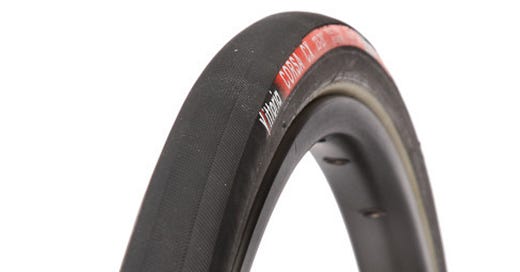What keeps tubeless tires on their rims?
Road tubeless tires are held on differently than tubed clinchers and are more vulnerable to coming off the rim
The reader Q&A for today is responding to comments from some readers in the bike industry.
Last week in a video conference call with him and two Zipp/SRAM wheel product managers, SRAM’s marketing director told me that I am scaring people with my recent posts about the safety of road tubeless systems. He said that people always fear new bike technologies, and then those technologies end up being ubiquitous. He pointed to road disc brakes and superlight carbon frames as being things we were afraid of, both of which are now universally adopted. Point taken.
The SRAM marketing director further contended that “bikes have never been safer.” I believe that is true when it comes to hydraulic disc brakes vs. rim brakes. However, I think that tubeless-equipped road race bikes are less safe than tubular-equipped ones, and I don’t believe that is just a knee-jerk fear of new technology.
There is the danger of the tubeless tire coming off the rim when flat as I’ve discussed here. Due to sealant filling small holes, tubeless tires do have a leg up on tubulars (except tubeless tubulars) in being less likely to go flat from small punctures like thorns, glass and tacks. Counterbalancing that, I also believe that cornering control is not as good with tubeless tires on modern wide rims as handmade tubulars, because the wider rim make the sidewalls more vertical.
We all know that safety with tubular tires depends on proper gluing to the rims. While many amateurs have screwed this up and ended up rolling their tires off the rims, I can’t think of a single incidence of a rolled tubular tire in a pro race with pro team mechanics gluing them on. Even Joseba Beloki’s tubular stayed on during violent fishtailing leading to the crash ending in Lance Armstrong’s historic cyclocross ride on stage 9 of the 2003 Tour de France. [Ed. note: Beloki’s tubular DID roll off; see this subsequent post:
I had not noticed that in the replays of the video on TV at the time.]
Without doubt, a consumer or amateur racer is more likely to be able to properly install a tubeless tire than a tubular one, but that’s an entirely different question than which tires pro riders, who ride faster than anybody else, are safest on.
Any longtime racing fan can remember instances where riders on tubulars flatted on downhills and stopped safely. Go to 1:28.05 in this video of Abraham Olano winning the worlds in Colombia in 1995, and you’ll see Olano pedaling solo the last kilometers on a completely flat rear tire with Marco Pantani, Mauro Gianetti, and Miguel Indurain in hot pursuit. He not only cannot afford the time to stop and switch bikes, but they will also catch him if he slows down much. He keeps pounding away in high gear with his tubular tire completely flat. A flat tubeless road tire in that scenario would have come off the rim, and Olano would not have gotten the rainbow jersey.
Fortunately, Remco Evenepoel was able to get a new bike in time to still win the Olympic Road Race gold medal last Saturday. However, if the team car had not been there, he could not have ridden to the finish on a clincher, tubed or tubeless, whereas he may have been able to on a flat tubular.
I recall conversations with former Zipp engineer Josh Poertner (now CEO of Silca) about all the work his team at Zipp did to make a 303 tubular wheel to win Paris-Roubaix. The rim had to become more compliant, not stronger—as umpteen broken stronger wheels in the test lab demonstrated. The video at the top of this post shows it (and the tubular tire) absorbing the sharp bump in the lab. Key to that was the box construction of the tubular rim, which also happens to be lighter than a clincher rim, hooked or hookless. The wheel they came up with won Paris-Roubaix for five straight years, from 2010-2014 under Fabian Cancellara, Johan Vansummeren, Tom Boonen, Cancellara, and Niki Terpstra.
I learned a very clear lesson about how differently a tubeless tire is retained on a rim than a tubed clincher in my first experience of riding a road tire tubeless around 20 years ago. For years, I had ridden Vittoria Open Corsa CX clinchers (with inner tubes) because they rolled and cornered so nicely. Stan’s NoTubes had just come out with its sealant, and MTB XC racers were running standard MTB tires tubeless with “Stan’s” inside to gain the tubeless advantage without the weight and stiffness of UST tires. Steve Hed told me that he had run standard road clinchers tubeless with liquid latex from a hardware store inside, so I thought I’d try that with my 700 X 23C Open Corsa CX clinchers. I had Mavic Ksyrium wheels, which had no spoke holes in the rim bed, so all I needed was a Stan’s tubeless valve and his sealant, right?
Keep reading with a 7-day free trial
Subscribe to Technical Q&A with Lennard Zinn to keep reading this post and get 7 days of free access to the full post archives.






